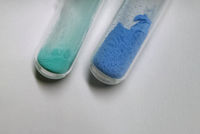Difference between revisions of "Copper citrate"
| Line 1: | Line 1: | ||
{{Chembox | {{Chembox | ||
| − | | Name = | + | | Name = Copper citrate |
| Reference = | | Reference = | ||
| IUPACName = | | IUPACName = | ||
| Line 68: | Line 68: | ||
| pKa = | | pKa = | ||
| pKb = | | pKb = | ||
| − | | Solubility = | + | | Solubility = Slightly soluble |
| SolubleOther = | | SolubleOther = | ||
| Solvent = | | Solvent = | ||
| Line 119: | Line 119: | ||
Copper citrate is soluble in alkaline citrate solutions. | Copper citrate is soluble in alkaline citrate solutions. | ||
| − | The hydrated salt will lose its water of crystallization at | + | The hydrated salt will lose its water of crystallization at 100 °C, turning from green to blue. |
When heated more strongly, the salt decomposes, leaving behind solid copper particles. When heated under vacuum, the residue is claimed to be pyrophoric <ref>Gorrie, T., Kopf, P., & Toby, S. (1967). Kinetics of the reaction of some pyrophoric metals with oxygen. The Journal of Physical Chemistry, 1478(4), 3842–3845. Retrieved from http://pubs.acs.org/doi/pdf/10.1021/j100871a019</ref> | When heated more strongly, the salt decomposes, leaving behind solid copper particles. When heated under vacuum, the residue is claimed to be pyrophoric <ref>Gorrie, T., Kopf, P., & Toby, S. (1967). Kinetics of the reaction of some pyrophoric metals with oxygen. The Journal of Physical Chemistry, 1478(4), 3842–3845. Retrieved from http://pubs.acs.org/doi/pdf/10.1021/j100871a019</ref> | ||
Revision as of 17:41, 28 March 2016

| |
| Properties | |
|---|---|
| Molar mass | Cu3C12H10O14 |
| Slightly soluble | |
| Related compounds | |
| Except where otherwise noted, data are given for materials in their standard state (at 25 °C [77 °F], 100 kPa). | |
| Infobox references | |
Copper(II) citrate, also known as cuprocitrol, is an ionic compound of copper and citric acid with the formula Cu3(C6H5O7)2 or Cu3C12H10O14, with a molecular weight of 568.85 g/mol. Some resources incorrectly list its formula as Cu2C6H4O7 and a molecular weight of 360.2 g/mol, but this formulation would require the citric acid molecule to lose more protons than it has carboxylic groups. It exists as a seafoam green hemipentahydrate and a sky-blue anhydrous solid.
Contents
Properties
Chemical
Copper citrate is soluble in alkaline citrate solutions.
The hydrated salt will lose its water of crystallization at 100 °C, turning from green to blue.
When heated more strongly, the salt decomposes, leaving behind solid copper particles. When heated under vacuum, the residue is claimed to be pyrophoric [1]
Physical
Preparation
Copper citrate can be made by reacting copper oxide or hydroxide with citric acid.
Copper citrate has a low solubility in water, and can be prepared by precipitation from aqueous solution containing copper and citrate ions. A procedure is available from the Royal Society for Chemistry[2] describing its preparation from citric acid or trisodium citrate and copper acetate or sulfate. However, when followed, the reaction proceeds only very slowly, and deposits the product as a crust. Heating the mixture will accelerate the reaction and give a finely-divided product.
Magnesium citrate, available in solution as a laxative, can also be used in place of trisodium citrate.
Projects
Handling
Safety
Copper citrate is fairly benign.
Storage
In closed bottles, or sealed if you want the anhydrous form.
Disposal
Copper citrate should be disposed of just any other copper compound.
References
- ↑ Gorrie, T., Kopf, P., & Toby, S. (1967). Kinetics of the reaction of some pyrophoric metals with oxygen. The Journal of Physical Chemistry, 1478(4), 3842–3845. Retrieved from http://pubs.acs.org/doi/pdf/10.1021/j100871a019
- ↑ Preparation of copper(II) citrate. RSC Student worksheet, http://www.rsc.org/learn-chemistry/resource/download/res00000903/cmp00001141/pdf